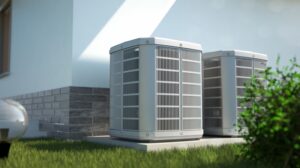
A heat pump is an excellent alternative to the standard HVAC setup of an air conditioner and a furnace. In operation, a heat pump resembles a central air conditioning system. Most of the components are the same: an outdoor cabinet with a compressor, fan, and refrigerant coil, and an indoor unit with an evaporator coil and air handler. The compressor places refrigerant under pressure so it circulates between the two sets of coils to carry out heat exchange.
A heat pump has several different components in it that allow it to work as a heating system in addition to a cooling system:
The Reversing Valve
This is the essential component that allows a heat pump to work as both a cooling and heating system. The valve is located near the outdoor compressor. As heated, high-pressure refrigerant leaves the compressor, it first enters the valve. Depending on how the valve is set, it will either direct the refrigerant toward the outdoor coil, which puts the heat pump in cooling mode, or to the indoor coil, which puts it in heating mode. The thermostat has a direct connection to the reversing valve to cause this shift in operation.
The Second Expansion Valve
The expansion valve in an air conditioner is located along the refrigerant line returning from the condenser coil, where the refrigerant has just released heat to cool down. The expansion valve causes the refrigerant pressure to drop, which also causes its temperature to drop so it’s cold when it moves through the evaporator coil. A heat pump has two expansion valves to handle lowering the pressure of the refrigerant when it moves in the opposite direction.
The Defrost Controls
Heat pumps operate during winter; air conditioners do not. This creates an issue for a heat pump during winter operation, which is ice and frost developing on the outdoor coil during evaporation, which draws moisture onto the coil as it absorbs heat. To prevent this icing problem, a heat pump has defrost controls that register the temperature of the coil and the outdoor temperature. When the temperatures drop low enough, the controls stop the outdoor fan and cause the reversing valve to temporarily shift the movement of refrigerant so the coil releases heat. This defrosts the coil so the heat pump can get back to standard operation without ice blocking heat absorption.
The Suction Accumulator
This device protects the compressor from liquid refrigerant moving the wrong direction into it. If cold liquid refrigerant enters the compressor, it will mix with the oil (a condition called slugging) and can lead to the compressor dying. The shifting of the direction of refrigerant flow in a heat pump makes it more likely for this situation to happen, so a suction accumulator placed near the compressor helps to prevent this backflooding, filling up before enough refrigerant accumulates to enter the compressor.
If you have problems with your heat pump, call us for the heat pump repair in Conyers, GA that will ensure you receive great cooling and heating whenever you need it.
Call Premier Heating & Air and Experience the Premier Difference!

